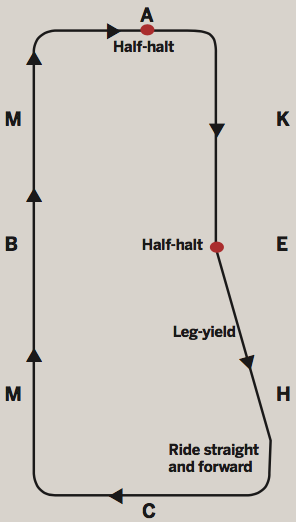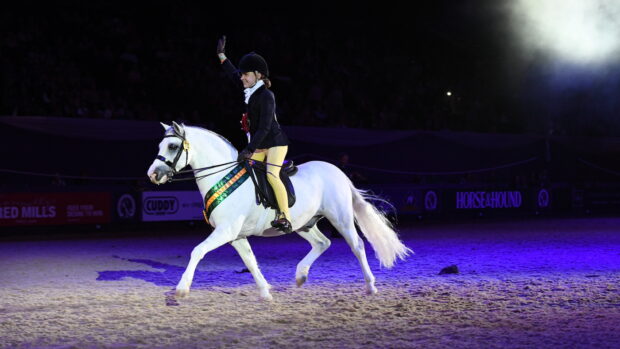This is a simple leg-yielding exercise from Sue-Helen Shuttleworth (pictured) for both established and young horses, enabling the rider to master the art of flexion and the correct use of the inside rein
Aim
The aim of this leg-yielding exercise is to lighten the horse to the forehand while improving strength, balance, suppleness and straightness. It also helps to teach him to move away from the inside leg and work into the outside hand.
The idea is that the horse has a slight flexion at the poll, away from the direction of travel. His inside legs should cross in front of his outside legs, which is done while maintaining a forward rhythm. A horse who appears light and easy to ride in the show ring is more likely to attract the judge’s attention.
The exercise

1. It’s best to start in walk, as this will help both horse and rider to understand and coordinate the aids. Then move up to trot.
2. Starting on the right rein, go large around the arena and establish a balanced and forward walk or working trot, while asking for a small amount of flexion with your right rein. Try to use a little “feel and release”. The inside rein is there to guide your horse — it’s not there to drag him around the bends and turns. I like to make sure I can see just the corner of the horse’s eye.
3. When you reach A on the short side of the arena, apply a half-halt using the outside rein to signal you would like your horse to wait and listen for his next instruction. Then ride on to the three-quarter line. I like to ride straight down this line once before asking for the sideways action.
4. Repeat the above, but this time ride halfway down the three-quarter line before applying another half-halt. Put your right leg very slightly behind the girth and ask him to move sideways, shoulder first, towards the fence, while maintaining the right flexion.
5. Your left leg is used to maintain the forward rhythm, control the angle of his body and prevent him from falling out on to his left side. If the horse gives too much inside bend, remember to keep an elastic feel down the inside rein and support the angle of the bend by using your outside rein and leg.
6. When you reach the edge of the arena, praise the horse and give the right rein to keep him soft. Once back on the track, ride straight again while maintaining forward momentum. Change the rein and repeat.
Article continues below…
You might also be interested in:
Tips and pitfalls
- Sometimes the horse doesn’t understand the inside leg aid and ignores it. If so, start in walk and use your stick to back up the leg aid — a few small taps on the shoulder encourages the horse to move quietly away from the leg.
- He might misunderstand the leg aid and rush forward. Repeat your half-halts and be quick to release the rein, so he remains relaxed. Once the horse understands the aids in walk, the trot work will follow.
- If the horse anticipates the movement across, try riding down the centre line and leg- yield to the three-quarter line.
- If the horse leads with the quarters, ride straight out of the movement and ask again, this time with your inside leg slightly more forward.
- Lots of qualifiers now ask for a more precise and technical ridden display. This can include walk to canter or cantering on the straight. I find it beneficial in training to use the leg-yield exercise just before asking for canter to encourage straightness and the correct lead.
For all the latest equestrian news and reports, don’t miss Horse & Hound magazine, out every Thursday



